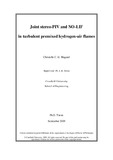JavaScript is disabled for your browser. Some features of this site may not work without it.
| dc.contributor.advisor | Moss, J. B. | |
| dc.contributor.author | Magand, Christelle C. G. | |
| dc.date.accessioned | 2010-07-12T09:24:28Z | |
| dc.date.available | 2010-07-12T09:24:28Z | |
| dc.date.issued | 2009-09 | |
| dc.identifier.uri | http://hdl.handle.net/1826/4484 | |
| dc.description.abstract | A new technique to simultaneously and instantaneously resolve 3D velocity/2D strain rate fields and scalar/scalar gradient fields was developed and evaluated in this study. This technique combines Planar Laser Induced Fluorescence of the NO radical (NO-PLIF) and Stereoscopic Particle Image Velocimetry (SPIV). It was found that the NO-PLIF technique allowed the determination of various iso-c contours and as such would, in principle, allow the study of the influence of the heat release on various properties, provided a calibration of the NO-PLIF signal as a function of temperature is achieved. It was also shown that the NO-PLIF technique may not be unambiguous at detecting flame extinction. The SPIV technique allowed the determination of the velocities in 3D and of the strain rates in 2D from which the most extensive and the most compressive strain rates but not the intermediate strain rate could be extracted. Information on strain rates and progress variable gradients were of particular interest in this study as they were needed to study the turbulence-scalar interaction which appears explicitly in the transport equation for the scalar dissipation rate which was derived recently. Using the technique above mentioned, this work also aimed at gathering and analysing data such as flame normal orientation, progress variable gradients, velocity change across the flame front and strain rates along the flame contours in turbulent premixed hydrogen/air flames with added nitrogen. The flame normal orientation was found to be consistent with the regime of the flames studied. A new method was designed and presented to infer from the progress variable gradients the component of the flame normal in the third dimension. The velocity change across the flame front, inferred from the SPIV data, was found to be extremely small. It is thought that the (low) heat release of the flames studied contributed more to corrugation of the flame front than acceleration of the gases across the flame front. The strain rates were studied along apparently non-wrinkled and clearly wrinkled flame contours. Their variation could not successfully be linked to curvature solely. Their values were mostly below the value expected for extinction strain rates. Last, this study aimed at investigating the turbulence-scalar interactions in turbulent premixed hydrogen/air flames with added nitrogen via the characteristics of the alignment of the flame normal vectors with the principal strain rates. The results of this study are quite different from earlier experimental results obtained for turbulent premixed ethylene/air flames. The strong preferential alignment of the flame front normal with the most extensive strain rate observed for ethylene/air flames could not be observed for the hydrogen/air flames with added nitrogen studied in the present work. The key outcome of this study was that no preferential alignment could be observed for most of the flames. A slight preferential alignment of the flame front normal with the most compressive strain rate was observed for the flames with very low adiabatic flame temperature. The differences observed were attributed partly to Lewis number effects and partly to the low heat release superimposed on the hydrodynamic fields in the flames studied. | en_UK |
| dc.language.iso | en | en_UK |
| dc.publisher | Cranfield University | en_UK |
| dc.rights | © Cranfield University, 2009. All rights reserved. No part of this publication may b reproduced without the written permission of the copyright holder. | en_UK |
| dc.title | Joint stereo-PIV and NO-LIF in turbulent premixed hydrogen-air flames | en_UK |
| dc.type | Thesis or dissertation | en_UK |
| dc.type.qualificationlevel | Doctoral | en_UK |
| dc.type.qualificationname | PhD | en_UK |
